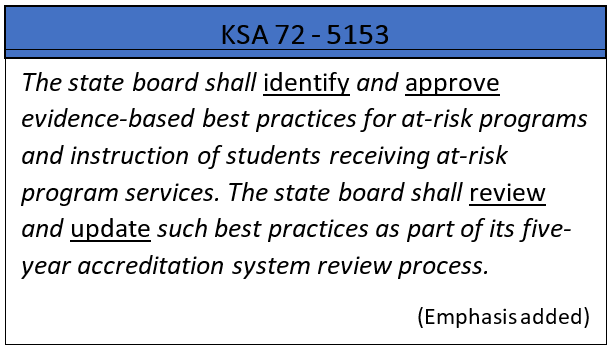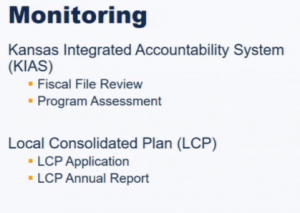 Included in SB 19 – the court-demanded ransom to increase to K-12 funding passed during the 2017 legislative session – was a higher weighting for at-risk students, meaning schools now get even more money that in theory is to be targeted to reduce income-based achievement gaps. Recognizing that schools have failed to close those achievement gaps despite the hundreds of millions of dollars per year in at-risk funding, SB 19 included a “best practices” requirement that was supposed to magically shrink those sizable and swelling gaps. However, the language of the statute has allowed the State Board of Education and KSDE to implement the new law by letting school districts continue to escape accountability for reducing achievement gaps.
Included in SB 19 – the court-demanded ransom to increase to K-12 funding passed during the 2017 legislative session – was a higher weighting for at-risk students, meaning schools now get even more money that in theory is to be targeted to reduce income-based achievement gaps. Recognizing that schools have failed to close those achievement gaps despite the hundreds of millions of dollars per year in at-risk funding, SB 19 included a “best practices” requirement that was supposed to magically shrink those sizable and swelling gaps. However, the language of the statute has allowed the State Board of Education and KSDE to implement the new law by letting school districts continue to escape accountability for reducing achievement gaps.
 A presentation at the September state board meeting is evidence of that point. KSDE’s Tate Toedman proudly unveiled a new website to the state board at the meeting. The website is considered the fulfillment of the legislative directive.
A presentation at the September state board meeting is evidence of that point. KSDE’s Tate Toedman proudly unveiled a new website to the state board at the meeting. The website is considered the fulfillment of the legislative directive.
Here’s all you need to know: it’s not going to make a dime’s worth of difference in dealing with the reality that low-income students are falling farther and farther behind their non-low-income schoolmates.
Unfortunately, the language of the law only requires more inputs to an already failing at-risk program. The emphasized words in the statute: identify, approve, review, and update have nothing at all to do with improving student outcomes, which is supposed to be the goal of the at-risk program. Those words allow KSDE to do nothing more than create process boxes to be checked off at some later date. Meanwhile, achievement gaps continue to get bigger and bigger…
KSDE has made most of the opportunity to continue to let school districts off the hook. As the accompanying panel shows (both panels were part of Toedman’s presentation), KSDE’s “monitoring” of districts’ adoption of “best practices” will provide ample cover from accountability. (I guess spending “only” about $400 million per year prior to SB 19 didn’t rise to a call for scrutiny.) Monitoring will include such strict adherence protocols as infrequent “fiscal file reviews” and “program assessment.” Scary stuff to be sure. The required reporting in districts’ Local Consolidated Plans, which was emphasized by Mr. Toedman, is something districts already must do.
shows (both panels were part of Toedman’s presentation), KSDE’s “monitoring” of districts’ adoption of “best practices” will provide ample cover from accountability. (I guess spending “only” about $400 million per year prior to SB 19 didn’t rise to a call for scrutiny.) Monitoring will include such strict adherence protocols as infrequent “fiscal file reviews” and “program assessment.” Scary stuff to be sure. The required reporting in districts’ Local Consolidated Plans, which was emphasized by Mr. Toedman, is something districts already must do.
 This level of scrutiny has fewer teeth than a veteran hockey player.
This level of scrutiny has fewer teeth than a veteran hockey player.
There’s not a single mention of student outcomes such as state assessment results anywhere – and speaking of state assessment results, why haven’t the 2018 scores been released yet? (That will be the subject of my next article.)
There’s a tragic irony in all this. The Legislature’s “best practices” requirement in SB 19 was supposed to be an attempt to show the Supreme Court that they were getting serious about reducing achievement gaps, but the language of the law actually codified a complete absence of accountability. In doing so, the state board and KSDE took advantage by providing schools districts another layer of protection from accountability.
Ultimately the big losers are the very students who are supposed to be the winners.





